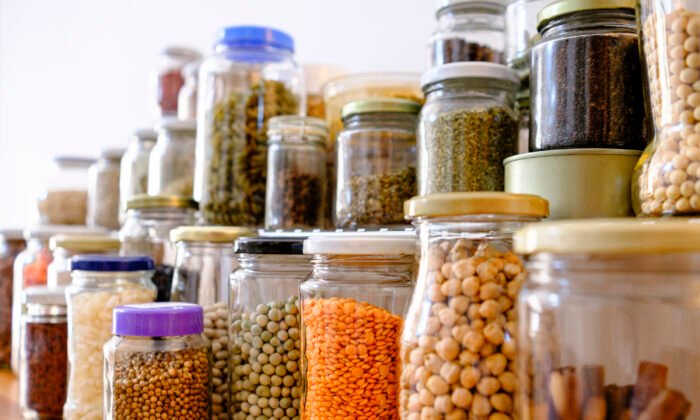Unlock Your Full Potential with These Brain-Boosting Pantry Staples
Putting a little thought into maintaining a well-stocked pantry is the best starting point to launch into better eating habits. A few hardworking ingredients mean you can create a delicious and nutritious meal quickly. This is important if you’re cooking for one or you’re too tired to cook anything more fancy than a piece of toast for dinner every night. Here is a list of things good to keep on hand, and you will find pretty much everything on it at your local supermarket or health-food store.
Spices
Spices and herbs bring bold flavor to dishes. All spices contain antioxidants—they are what give them their color and much of their flavor—and many have been shown to also have helpful anti-inflammatory properties. Remember, though, that much of the talk you might hear about the benefits of turmeric (curcumin), cinnamon, rosemary and others usually is based on studies where the amounts used were well beyond what you could practically eat (usually given in pill form), so the findings of these studies don’t always apply to the amounts you might eat in foods. It’s also important to realize that, when any food component or herb is eaten in quantities way beyond what could usually be found in food, they behave more like medications than like food. Because of that, there can be consequences to your health from taking some of these in the amounts available in pills. Many can interact with medications you might be taking, or affect your liver and other organs. By contrast, when these are eaten in the amounts in these recipes, and especially when they have the chance to interact with other food components which balance or even enhance their benefits, there is plenty to be gained.
Cinnamon
This excellent spice has had a bit of attention in recent years, having been found to assist in diabetes management and maintaining healthy cholesterol levels. For these reasons as well as the variety of antioxidants and anti-inflammatory substances it offers, there are also benefits for the brain. Be aware, though, that there are two main types of cinnamon on the market and they do have somewhat different properties. All are sold either as sticks, which are rolled bark, or powdered. “True” cinnamon (with the botanical name of Cinnamomum verum, but also known as Cinnamomum zeylanicum) comes mostly from Sri Lanka (it’s sometimes still called Ceylon cinnamon despite that country’s name change on becoming a republic more than 40 years ago!) and southern India. The bark is thin so the stick is many layered and closely rolled, but is also quite fragile and can be easily broken up in your hand. In contrast, what is more commonly available is “cassia” cinnamon (Cinnamomum cassia), usually from China, Vietnam or Indonesia: the bark is thicker and the stick is just one or two layers. It’s not fragile and doesn’t easily break in your hand. When it comes to ground cinnamon, it’s a bit difficult to know what type of cinnamon you are eating, as the labels don’t always specify the source or the type; however, in nutritional terms, it might not matter. You might read claims that only “true” cinnamon is of benefit to the brain; however, many studies that have investigated the health benefits of cinnamon have used cassia cinnamon or didn’t specify the type at all. So, the benefits have been shown from either type. Both contain valuable antioxidants and anti-inflammatory substances.
Turmeric (curcumin)
This can be used fresh if you can get it (grate it straight into dishes or sprinkle on top), but ground turmeric is the one that is easy to keep in your pantry. This beautiful golden spice—best known in dishes from India, Pakistan, Morocco and the Middle East—is creating a bit of a stir in neuroscience research. The research being done uses much larger amounts than we would normally eat, so the benefits available from what’s in these recipes are not quite the same; however, what we have here is a combination of this lovely spice with a variety of other ingredients that all contain antioxidant substances and ingredients that supply a number of valuable nutrients. Research has shown that turmeric needs fat or oil to be absorbed.
Cumin, coriander and fennel seeds
All of these seeds have plenty of antioxidants, along with the protein that is offered by all seeds. Keep whole seeds as well as ground, if you have space for both. Freshly ground seeds tend to have a stronger flavor, so it’s a great idea to keep whole seeds, dry roast them for a couple of minutes, then grind them as you need them using a mortar and pestle or spice grinder.
Paprika
This vibrant spice is the dried skin and flesh of bell peppers; the flavor and color depend on the varieties that are used and whether the peppers have been smoked or not before drying and grinding. Most paprika you will buy in a grocery store will be either sweet, hot or smoked. The sweetness in the first comes only from the sugars naturally found in the pepper. It is the perfect one for most dishes. The hot varieties incorporate some more chili-like varieties to give extra zing, and then of course there is cayenne pepper, which is a type made from the hot and spicy cayenne pepper. Smoked paprika is made from peppers that have been smoked before drying and grinding. They give many Spanish, Mexican and Moroccan dishes their warm and dusky flavor and unique appeal. Whichever paprika you choose, be assured that it is packed with antioxidants. As always, use the freshest you can get to ensure the best flavor.
Nuts and Seeds
Walnuts are especially high in omega-3 fats, but all nuts contain protein, antioxidants and an array of useful brain-supporting nutrients, so keep a variety on hand; walnuts, almonds, hazelnuts, pine nuts, pecans; as well as seeds such as pumpkin, sesame, sunflower and poppy seeds. Both nuts and seeds store quite well; however, when you buy them, check use-by dates and try to use them promptly, as the oils they contain can degrade in time (particularly in light, warm places). If you are keeping them for a while and you live in a warm or tropical area, its useful to keep them in the fridge or a cool place but allow them to return to room temperature to eat them for the best flavor.
Grains (quinoa, whole-wheat couscous, farro (spelt) and pearl barley)
Quinoa is not technically a grain; it is a pseudo-cereal and has a nutritional profile that actually makes it superior to most grains commonly used. There are three varieties usually available: white, red and black and often you will find a mixture of all three. Nutritionally they are practically the same. The seeds are coated with substances called saponins that help protect the plant from pests and diseases, and you might read that these are “toxic” to humans so that quinoa needs lots of washing to remove them before you can eat it. Saponins have a “soapiness” when they dissolve in water so the rinsing process produces frothy water. It’s often suggested that quinoa be rinsed till the water runs clear so you know the saponins are gone, but more recent thinking suggests that saponins might be helpful to human health so, while washing is certainly advisable and also helps to reduce the bitterness, you don’t need to be as meticulous about washing as you might have read elsewhere. Quinoa is predominantly a cold-climate crop, although production is spreading. It has about twice the protein of rice and similar grains, and that protein is what is called “complete” because, like animal foods, it contains all the essential amino acids; that’s unique among plant foods. It’s extra-high in fiber and, unlike most grains, it is a good source of a number of important minerals including iron and zinc.
LSA
LSA is an acronym for a ground mixture of linseeds (flaxseeds), sunflower seeds and almonds and is a powerhouse of nutritional goodness. It’s loaded with omega-3 fats, adds a protein boost to many dishes, and is an excellent source of probiotic dietary fiber to help your brain as well as your digestive system.




